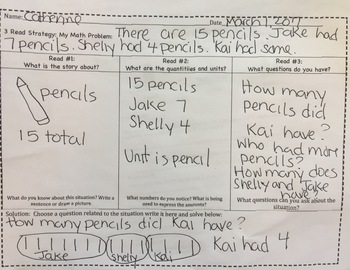3 Reads Template Problem Solving
Teacher Prep
215 Followers
Grade Levels
K - 12th
Subjects
Resource Type
Standards
CCSS2.OA.A.1
CCSSMP1
Formats Included
- Word Document File
Teacher Prep
215 Followers
What educators are saying
Highly versatile and comprehensive resource! Clear instructions and creative content cater to diverse learners. Seller's ongoing support is exceptional. A must-have for educators looking to elevate their classroom instruction.
I love the three-reads strategy. It gets the students to think about the problem and not just jump in to solve it.
Description
Template for using the 3 Reads strategy for Mathematical Problem Solving
For detailed instruction on how to use this approach see my blog post on using this template here:
For detailed instruction on how to use this approach see my blog post on using this template here:
Total Pages
Answer Key
N/A
Teaching Duration
N/A
Report this resource to TPT
Reported resources will be reviewed by our team. Report this resource to let us know if this resource violates TPT’s content guidelines.
Standards
to see state-specific standards (only available in the US).
CCSS2.OA.A.1
Use addition and subtraction within 100 to solve one- and two-step word problems involving situations of adding to, taking from, putting together, taking apart, and comparing, with unknowns in all positions, e.g., by using drawings and equations with a symbol for the unknown number to represent the problem.
CCSSMP1
Make sense of problems and persevere in solving them. Mathematically proficient students start by explaining to themselves the meaning of a problem and looking for entry points to its solution. They analyze givens, constraints, relationships, and goals. They make conjectures about the form and meaning of the solution and plan a solution pathway rather than simply jumping into a solution attempt. They consider analogous problems, and try special cases and simpler forms of the original problem in order to gain insight into its solution. They monitor and evaluate their progress and change course if necessary. Older students might, depending on the context of the problem, transform algebraic expressions or change the viewing window on their graphing calculator to get the information they need. Mathematically proficient students can explain correspondences between equations, verbal descriptions, tables, and graphs or draw diagrams of important features and relationships, graph data, and search for regularity or trends. Younger students might rely on using concrete objects or pictures to help conceptualize and solve a problem. Mathematically proficient students check their answers to problems using a different method, and they continually ask themselves, "Does this make sense?" They can understand the approaches of others to solving complex problems and identify correspondences between different approaches.


